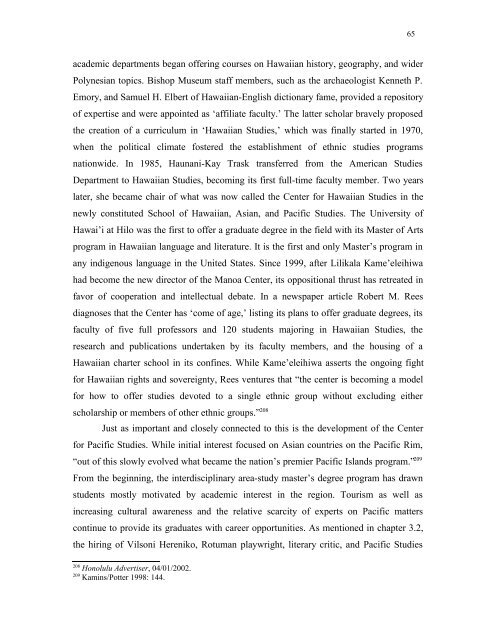A Paradise Lost - KOPS - Universität Konstanz
A Paradise Lost - KOPS - Universität Konstanz
A Paradise Lost - KOPS - Universität Konstanz
You also want an ePaper? Increase the reach of your titles
YUMPU automatically turns print PDFs into web optimized ePapers that Google loves.
academic departments began offering courses on Hawaiian history, geography, and wider<br />
Polynesian topics. Bishop Museum staff members, such as the archaeologist Kenneth P.<br />
Emory, and Samuel H. Elbert of Hawaiian-English dictionary fame, provided a repository<br />
of expertise and were appointed as ‘affiliate faculty.’ The latter scholar bravely proposed<br />
the creation of a curriculum in ‘Hawaiian Studies,’ which was finally started in 1970,<br />
when the political climate fostered the establishment of ethnic studies programs<br />
nationwide. In 1985, Haunani-Kay Trask transferred from the American Studies<br />
Department to Hawaiian Studies, becoming its first full-time faculty member. Two years<br />
later, she became chair of what was now called the Center for Hawaiian Studies in the<br />
newly constituted School of Hawaiian, Asian, and Pacific Studies. The University of<br />
Hawai’i at Hilo was the first to offer a graduate degree in the field with its Master of Arts<br />
program in Hawaiian language and literature. It is the first and only Master’s program in<br />
any indigenous language in the United States. Since 1999, after Lilikala Kame’eleihiwa<br />
had become the new director of the Manoa Center, its oppositional thrust has retreated in<br />
favor of cooperation and intellectual debate. In a newspaper article Robert M. Rees<br />
diagnoses that the Center has ‘come of age,’ listing its plans to offer graduate degrees, its<br />
faculty of five full professors and 120 students majoring in Hawaiian Studies, the<br />
research and publications undertaken by its faculty members, and the housing of a<br />
Hawaiian charter school in its confines. While Kame’eleihiwa asserts the ongoing fight<br />
for Hawaiian rights and sovereignty, Rees ventures that “the center is becoming a model<br />
for how to offer studies devoted to a single ethnic group without excluding either<br />
scholarship or members of other ethnic groups.” 208<br />
Just as important and closely connected to this is the development of the Center<br />
for Pacific Studies. While initial interest focused on Asian countries on the Pacific Rim,<br />
“out of this slowly evolved what became the nation’s premier Pacific Islands program.” 209<br />
From the beginning, the interdisciplinary area-study master’s degree program has drawn<br />
students mostly motivated by academic interest in the region. Tourism as well as<br />
increasing cultural awareness and the relative scarcity of experts on Pacific matters<br />
continue to provide its graduates with career opportunities. As mentioned in chapter 3.2,<br />
the hiring of Vilsoni Hereniko, Rotuman playwright, literary critic, and Pacific Studies<br />
208 Honolulu Advertiser, 04/01/2002.<br />
209 Kamins/Potter 1998: 144.<br />
65

















